Smoking - A
Cooking Technique
|
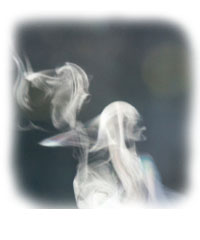 In the culinary
world, the term "holy smoke" is a term of reverence and awe, not a
random exclamation of surprise. Smoke is that essential, ethereal
ingredient that, along with low cooking temperatures, transforms
plain and tough, into succulent and tender. In the culinary
world, the term "holy smoke" is a term of reverence and awe, not a
random exclamation of surprise. Smoke is that essential, ethereal
ingredient that, along with low cooking temperatures, transforms
plain and tough, into succulent and tender.
What is smoking? - Smoking is a
variation of barbecuing -- low temperature cooking with an emphasis
on producing plenty of smoke thanks to smoldering hardwoods. The low
temperatures that promote smoke also tenderize the food. The
leisurely cooking times break down stubborn fibers. Tough,
inexpensive meats are transformed into melt-in-your-mouth morsels.
Beyond the tradition of smoked meats, really anything can be smoked.
(Try the recipe below that uses a smoked onion).
How to Smoke - Smoking can be
accomplished on a traditional grill or in a specifically constructed
smoker. As an indirect cooking method, smoking is completed near the
heat source, not over the heat source. Soaked wood is added to the
heat source and the wisps of flavor begin to swirl around food. It's
a test of patience, however -- it's the long, slow cooking that
makes it all work.
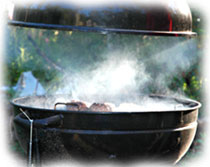 Smoking
on a Charcoal Grill - To turn a conventional charcoal grill
into a smoker, light the charcoal and allow it to find its simmering
point - the point where the briquettes are completely covered with a
fine, white ash. Push the coals to the outer edge of the grill
leaving the center free to hold a drip pan. Deploy a pie tin, or
another suitably-sized pan to catch any drips of fat or meat juice.
(Smoke generated from burning grease is not desirable). Place
soaked, drained wood chips on top of the smoldering coals and cover
the grill. The temperature inside the grill should ideally be
between 200°-220°F. Smoking
on a Charcoal Grill - To turn a conventional charcoal grill
into a smoker, light the charcoal and allow it to find its simmering
point - the point where the briquettes are completely covered with a
fine, white ash. Push the coals to the outer edge of the grill
leaving the center free to hold a drip pan. Deploy a pie tin, or
another suitably-sized pan to catch any drips of fat or meat juice.
(Smoke generated from burning grease is not desirable). Place
soaked, drained wood chips on top of the smoldering coals and cover
the grill. The temperature inside the grill should ideally be
between 200°-220°F.
Smoking
on a Gas Grill - Smoking on a gas grill is facilitated by a
built-in smoker box that heats the wood to a higher smoking
temperature while keeping the rest of the grill at a lower
temperature. If your grill does not have a built-in smoker box for
holding wood chips, a separate smoke box can obtained and put to
use. Or, the smoking effect can be simulated by placing soaked,
drained wood chips in a vented aluminum foil packet and placing the
packets beneath the grate.
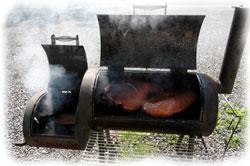 Smoking in a Smoker - You may find
yourself enamored with smoking to the point that you require a
dedicated smoking set-up. Smokers generally come in two styles
- horizontal or vertical. A horizontal smoker is typically
barrel-shaped with the fire source off to one end. The burning wood
in the firebox floats smoke into the barrel and vents through the
opposite end surrounding the food with a continuous airflow of
smoke. Vertical smokers, also often barrel-shaped, have three
layers: the firebox is loaded from below, a water pan rests above,
and the grill rack sits on top. The water pan provides moisture
throughout the cooking process offsetting the drying effect of the
smoke. Smoking in a Smoker - You may find
yourself enamored with smoking to the point that you require a
dedicated smoking set-up. Smokers generally come in two styles
- horizontal or vertical. A horizontal smoker is typically
barrel-shaped with the fire source off to one end. The burning wood
in the firebox floats smoke into the barrel and vents through the
opposite end surrounding the food with a continuous airflow of
smoke. Vertical smokers, also often barrel-shaped, have three
layers: the firebox is loaded from below, a water pan rests above,
and the grill rack sits on top. The water pan provides moisture
throughout the cooking process offsetting the drying effect of the
smoke.
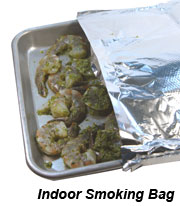 Smoking Indoors - This sounds like
an oxymoron, but for some apartment dwellers, or to satisfy
wintertime cravings, it's quite possible to get authentic smoked
flavor in your food while cooking indoors. Stovetop smokers are
available that have a bottom layer to hold the wood chips or
sawdust, a middle layer drip pan, and a top layer food grate. The
same principle applies, low heat and longer cooking times. Another
indoor alternative is a one-time use smoking bag. The aluminum pouch
has an inner pouch containing the wood. Foods are placed inside and
the entire bag is crimped shut and placed in the oven. Thin cuts or
quick-cooking foods such as fish, chicken, and vegetables are ideal
candidates for smoking indoors. Smoking Indoors - This sounds like
an oxymoron, but for some apartment dwellers, or to satisfy
wintertime cravings, it's quite possible to get authentic smoked
flavor in your food while cooking indoors. Stovetop smokers are
available that have a bottom layer to hold the wood chips or
sawdust, a middle layer drip pan, and a top layer food grate. The
same principle applies, low heat and longer cooking times. Another
indoor alternative is a one-time use smoking bag. The aluminum pouch
has an inner pouch containing the wood. Foods are placed inside and
the entire bag is crimped shut and placed in the oven. Thin cuts or
quick-cooking foods such as fish, chicken, and vegetables are ideal
candidates for smoking indoors.
Manage the Temperature - For
barbecuing and smoking a temperature target of 200°-220°F is
desired. After the initial heating of the grill or smoker, the art
of barbecuing is, in part, maintaining the temperature in that sweet
zone. Measure the temperature of the smoking chamber and measure the
internal temperature of the food. If things are too cold, open the
vent to increase the air flow and fuel the fire. If too hot, add
some more wet wood chips to cool things down.
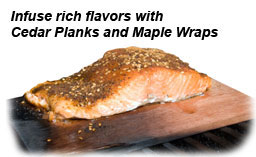
The Wood
Makes the Smoke - As one might guess, different types of wood
create different types of flavor as foods are smoked. Only hardwoods
should be used when smoking foods. Choose good wood; ensure that it
is not treated, that it contains no paint, nails, or other foreign
material. Strongly-flavored woods include hickory, mesquite, oak,
walnut; mellow-flavored woods range from maple, apple, cherry, and
apricot to other fruit tree
woods.
|
From Good to
Great Smoking and Grilling
|
There's always
something to be learned about grilling whether you're a novice or an
expert! Here are a few tips to advance or refresh your
skills:
Temperature,
temperature, temperature! - If there's a crime to be
committed on the grill it's cooking the food too long. This
situation usually arises from a fear of food-borne illness from
undercooked food. Using a thermometer and this temperature
chart will give you the confidence to pull the food off the grate
just at the right point of doneness whether you're smoking,
barbecuing, or grilling.
Many "grill artists" use two
thermometers when smoking: (1) the thermometer on the outside of the
smoker, and (2) an inside thermometer.  This second thermometer might be as simple as
an oven thermometer, or as up-to-date as a remote thermometer with
the probe placed appropriately in the center of the thickest portion
of the smoking food. This second thermometer might be as simple as
an oven thermometer, or as up-to-date as a remote thermometer with
the probe placed appropriately in the center of the thickest portion
of the smoking food.
When smoking larger cuts of meat and
using low temperatures, avoid opening the smoker or the grill lid
unless you're concerned about too high of heat at the onset. As the
old saying goes, "If you're lookin', it ain't cookin'!"
Keep it Safe! - Working with live
fire always calls for safe practices indoors or outdoors. Set
yourself up for success:
 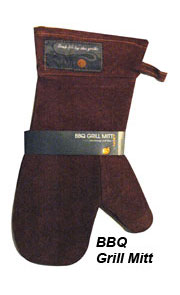 Mise en Place -
"Everything in place." Gather the tools, dishes, seasonings, etc.
prior to grilling. Mise en Place -
"Everything in place." Gather the tools, dishes, seasonings, etc.
prior to grilling.
Long Handles
Work! - It's true! Equipping your grilling life with the
proper, long-handled tools will keep your hands and arms safely
distant from the heat. Make sure the tool handles are insulated
well.
Mitts
and Hot Pads - Choose BBQ mitts and hot pads that are
fireproof or fire resistant. Long mitts that protect your forearm as
well as your hand are handy when using fire logs or when you're
manning a large grill.
Burn First-Aid
- Aim to prevent burns, but have a first-aid kit at the ready for
any minor accidents that might occur.
Special Handling! - The
possibilities on the grill explode with a couple of special tools.
If you haven't tried them, we guarantee they will greatly enhance
your outdoor cooking repertoire:
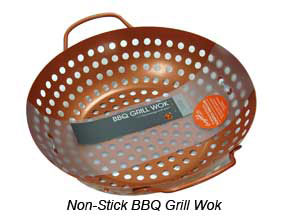 The Grill Grid, Basket, or Wok -
These tools allow vegetables or smaller cuts of meat to be grilled
easily and quickly without any food falling through the grate onto
the charcoal or burner. Seafood grilling works especially well with
these tools. The Grill Grid, Basket, or Wok -
These tools allow vegetables or smaller cuts of meat to be grilled
easily and quickly without any food falling through the grate onto
the charcoal or burner. Seafood grilling works especially well with
these tools.
Two-Sided Wire
Basket - This tool was originally developed for grilling
fish. It's still perfect for that, but we also find it's great for
grilling fruit, particularly slices of pineapple and stone fruits.
The delicate foods are safely cradled in the basket and easily
turned without sticking or
mangling. |
More Flavor
Layers
|
Good
ingredients, a little fire, and it's a great meal! Add a few
spices before, during, and after cooking, and the experience is
further enhanced. Before the food hits the grill, a variety of
preparation methods can be used to begin the "layering of flavors."
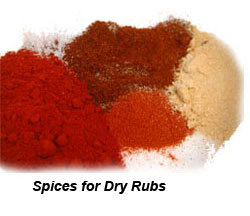 Dry
Rubs - Salt, sugar, and any number of spices may be rubbed
into the grill ingredient. The flavors of the rub remain primarily
on the surface. The sugar component in the rub will energize
the Maillard reaction that creates the flavorful browning on
meat. After massaging a dry rub into the surface of the meat,
let it sit for 10-15 minutes prior to grilling. Dry
Rubs - Salt, sugar, and any number of spices may be rubbed
into the grill ingredient. The flavors of the rub remain primarily
on the surface. The sugar component in the rub will energize
the Maillard reaction that creates the flavorful browning on
meat. After massaging a dry rub into the surface of the meat,
let it sit for 10-15 minutes prior to grilling.
Wet Rubs - Similar to a dry rub, a
wet rub, or paste, is a dense mixture of salt, sugar, spices, and
wet components such as olive oil, pureed fresh herbs, minced garlic,
etc. Wet rubs are useful with lean meats, such as boneless
chicken breasts because of the added moisture.
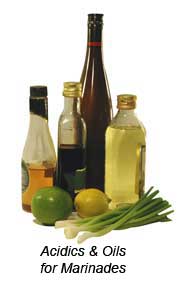 Marinades - Seasoned with herbs
and spices, a marinade is a liquid with an acidic character.
Vinegars or citrus juices all provide the required acidity.
Food items soaked in the liquid plump up. Plan on about one cup of
marinade for every pound of meat. The acidic quality begins the
breakdown of food resulting in a tender product. When marinating,
use a non-reactive pan or dish. Zippered plastic bags are
great for marinating. Do not reuse the marinade, nor should it be
used as a sauce or baste after it has been in contact with any raw
meat product. Marinades - Seasoned with herbs
and spices, a marinade is a liquid with an acidic character.
Vinegars or citrus juices all provide the required acidity.
Food items soaked in the liquid plump up. Plan on about one cup of
marinade for every pound of meat. The acidic quality begins the
breakdown of food resulting in a tender product. When marinating,
use a non-reactive pan or dish. Zippered plastic bags are
great for marinating. Do not reuse the marinade, nor should it be
used as a sauce or baste after it has been in contact with any raw
meat product.
Brines
- A brine is a combination of water, salt, and flavorings.
Ingredients soaked in a brine gather water and flavor through the
osmotic character of the sodium. The salt also begins to break down
proteins contributing to the tenderness. Brines are particularly
useful for pork and chicken where there is little marbling fat to
keep the meat moist.
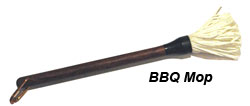 Mops and
Sops - A mop or a sop is a cross between a marinade and a
brine; it contains both acidic components and salty aspects. The
liquid is applied periodically during cooking with a mop-like hand
tool, hence the name. The mop/sop adds moisture and an ongoing
infusion of flavor. Mops and
Sops - A mop or a sop is a cross between a marinade and a
brine; it contains both acidic components and salty aspects. The
liquid is applied periodically during cooking with a mop-like hand
tool, hence the name. The mop/sop adds moisture and an ongoing
infusion of flavor.
Injections - With a large,
hypodermic-like needle, the brine or marinade flavors may be
injected into larger pieces of meat. A vacuum-based marinating dish
uses a vacuum to quickly pull the marinade deep into the food.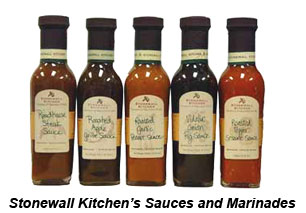
Sauces and Glazes - Is it the sauce
that makes the barbecue, or barbecue that makes the sauce?
It's a trick question - they're virtually inseparable! Most grilling
sauces and glazes have a strong sugar component. Because of
this, rapid carmelization takes place when exposed to high
heat. Too much heat for too long, and the sauce or glaze burns
-- a grilling disaster! To avoid this situation when grilling
with high heat, add the sauce during the last 5-10 minutes of
grilling saving some extra sauce for the
table.
|
Cooks'Wares
Smart Smoking and Grilling Tips
|
Tip #1: For pulled pork, beef
or chicken, deploy a low-and-slow temperature cooking technique -
low temperature (200°-220°F) for a long period of time. Pitmasters
recommend an internal temperature for the finished meat of 180°F, a
little higher than normal. The higher internal temperature makes the
meat pull apart and shred easily into perfection.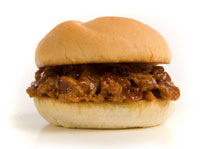
Tip
#2: Chips or chunks - match the size of wood pieces
used for smoking to the situation. The longer you plan to smoke the
food, the larger the pieces of wood that should be used. Soak
the wood for 30 minutes submerged in water, weighting the chips if
necessary. Drain and pat dry the soaked wood prior to adding to the
grill or smoker.
Tip
#3: Looking for some quick smoky taste in your
food? Try incorporating chipotle peppers, smoked paprika, or
smoked salt. Each of these products will share their smoky essence
with the rest of the ingredients to a wonderful, overall
effect!
Tip #4:
Monitor your marinating! It is possible to over-marinate your food.
The acidity in marinades breaks down protein structures tenderizing
the food in the process. Left too long, the process can turn
delicate foods like fish and shrimp into mush. Seafood should not be
marinated more than 30-60 minutes. Larger cuts of meat benefit from
overnight marinating. Steaks and chops are best after 2-3 hours of
marinating.
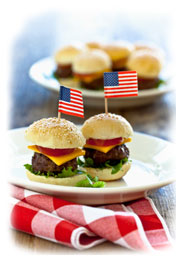
Tip
#5: Try grilling fruit for a perfect ending to your
summer meal. Stone fruits (peaches, apricots, plums, nectarines) or
slices of fresh pineapple are delicious when grilled. Improvise a
grilled fruit salsa with the addition of a chile, cilantro and some
citrus juice.
Tip
#6: Is the home team a fan of sliders? Make your own
quickly and easily with a slider maker. Sliders are those tiny
5-cent hamburgers made famous by White Castle. Add a single slice of
pickle, a dot of ketchup and mustard, and you're ready to
go!
Tip #7: Beer
can chicken has taken a leap forward with standing roasters. The
bottom tray catches drippings from the bird, and the stainless steel
composition eliminates any potential
contamination.
|
Q &
A's
|
 Q: What is liquid
smoke? Q: What is liquid
smoke?
 A: Liquid smoke is available
as a flavoring and is typically found near the Worcestershire sauce
in markets. Liquid smoke is made from condensated smoke dissolved in
water to create an easy-to-use flavoring solution. Liquid smoke is
strong - a few drops go a long way! A: Liquid smoke is available
as a flavoring and is typically found near the Worcestershire sauce
in markets. Liquid smoke is made from condensated smoke dissolved in
water to create an easy-to-use flavoring solution. Liquid smoke is
strong - a few drops go a long way!
Q: What's the best way to clean a
grill grate?
A: The test kitchens at
Cook's Illustrated recommend cleaning a grill by heating the grate
first, then brushing the rack with a long-handled, grill brush.
Finish the cleaning sequence by wiping the grate with a paper towel
soaked with vegetable oil and held by long-handled
tongs.
Q: What is the
difference between smoked food and smoke-cured
foods?
A:
Smoking as a cooking method differs from "smoke-cured." Foods
that are "smoke-cured," as in smoked salmon or beef jerky, are
preserved in a smoky environment, but without heat.
Q: Who invented the match? (great
party trivia...)
A: Early versions of today's
"friction match" have been around for centuries. However, the modern
match was developed by an English chemist, John Walker, in 1826.
Sticks of pine were dipped in a potion of phosphorous and sulfur
compounds and allowed to dry. Today's "safety match" was developed
in 1844 by Gustaf Erik Pasch of Sweden. The safety match was,
indeed, safer because it did not contain the dangerous chemical,
white phosphorous. More importantly, the two explosive
elements are separated - one component is on the match head, and the
other on the special striking surface. If you collect match-related
items, you engage in the hobby of phillumeny.
Q: How do I keep my barbecue from
getting a bitter flavor?
A: A by-product of burning
wood is creosote and is the substance responsible for a potential
bitter taste in smoked foods. The substance will also cause your
tongue to be numb. You can avoid creosote build-up on food by
keeping your smoker clean, and ensuring good airflow and proper
smoke-venting during cooking. |
Cooks'Wares'
Cookbook Review
|
Smoke &
Spice, Cooking with Smoke, the Real Way to Barbecue by Cheryl
and Bill Jamison. Copyright 2003. Published by The Harvard
Common Press, Boston, MA.
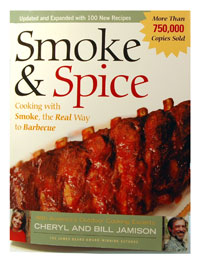 This book reintroduces the time-honored
tradition of long, slow cooking with smoke - something earlier
generations knew about easily and instinctively. In a fast food
culture, cooking slowly with low temperatures seems contrarian to
the times. But, it is precisely this counterpoint that has produced
a revival in barbecuing and its cousin, smoking. The authors,
assuming no foreknowledge, walk us through the basics of smoking in
a variety of scenarios, then provide an encyclopedia of recipes
spanning the classics and some clever, modern improvisations. The
cookbook is organized in the general categories of pork, beef, fowl,
fish, then veers off to the garden with vegetables, salads, pasta,
and pizza. The book finishes with a generous offering of side
dishes, condiments, desserts and drinks that match the barbecue
table well. Each page is peppered with insightful tips and
entertaining stories. It's engaging and
delightful! This book reintroduces the time-honored
tradition of long, slow cooking with smoke - something earlier
generations knew about easily and instinctively. In a fast food
culture, cooking slowly with low temperatures seems contrarian to
the times. But, it is precisely this counterpoint that has produced
a revival in barbecuing and its cousin, smoking. The authors,
assuming no foreknowledge, walk us through the basics of smoking in
a variety of scenarios, then provide an encyclopedia of recipes
spanning the classics and some clever, modern improvisations. The
cookbook is organized in the general categories of pork, beef, fowl,
fish, then veers off to the garden with vegetables, salads, pasta,
and pizza. The book finishes with a generous offering of side
dishes, condiments, desserts and drinks that match the barbecue
table well. Each page is peppered with insightful tips and
entertaining stories. It's engaging and
delightful!
|
Smoke and Grilling
Recipes
|
Excerpted from Smoke &
Spice by Cheryl and Bill Jamison. © 2003, used by permission
from The Harvard Common Press.
Jalapeno-Lime
Shrimp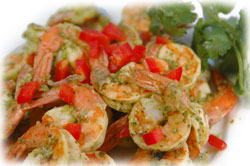
The marinade for this recipe is
fantastic! We loved its application for this shrimp presentation,
but immediately saw possibilities for a host of other uses. For this
recipe, we tried the indoor smoking bags mentioned above which
worked quite well. The shrimp were absolutely
delicious!
Click here to view the full
recipe.
Click here for a printable version of
the recipe.
Weeknight Pork
Tenderloin and
Wild Willy's Number One-derful
Rub
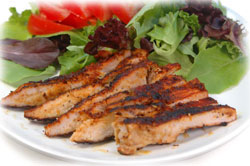 Despite the karma of cooking "low and
slow," we were looking for something that could be smoked and cooked
after work and before the summer sun set. This fit the bill! The rub
recipe included here is a great, basic rub that pairs well with a
number of foods. The pork smoked quickly in its butterflied
condition. The searing step sealed in the juices and made for a
moist, flavorful meal. Despite the karma of cooking "low and
slow," we were looking for something that could be smoked and cooked
after work and before the summer sun set. This fit the bill! The rub
recipe included here is a great, basic rub that pairs well with a
number of foods. The pork smoked quickly in its butterflied
condition. The searing step sealed in the juices and made for a
moist, flavorful meal.
Click here to view the full
recipe.
Click here for a printable version of
the recipe.
Smoked Onion
Sauce
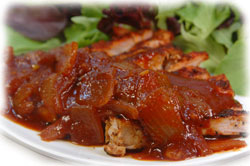 We smoked an onion along with the pork
tenderloin above. The soft, smoky onion became the basis for this
piquant sauce that complemented the pork tenderloin perfectly. We
liked the chunky style and the intense flavors. There was even
enough sauce for the grilled chicken breasts the next
evening. We smoked an onion along with the pork
tenderloin above. The soft, smoky onion became the basis for this
piquant sauce that complemented the pork tenderloin perfectly. We
liked the chunky style and the intense flavors. There was even
enough sauce for the grilled chicken breasts the next
evening.
Click here to view the full
recipe.
Click here for a printable version of
the
recipe.
| |